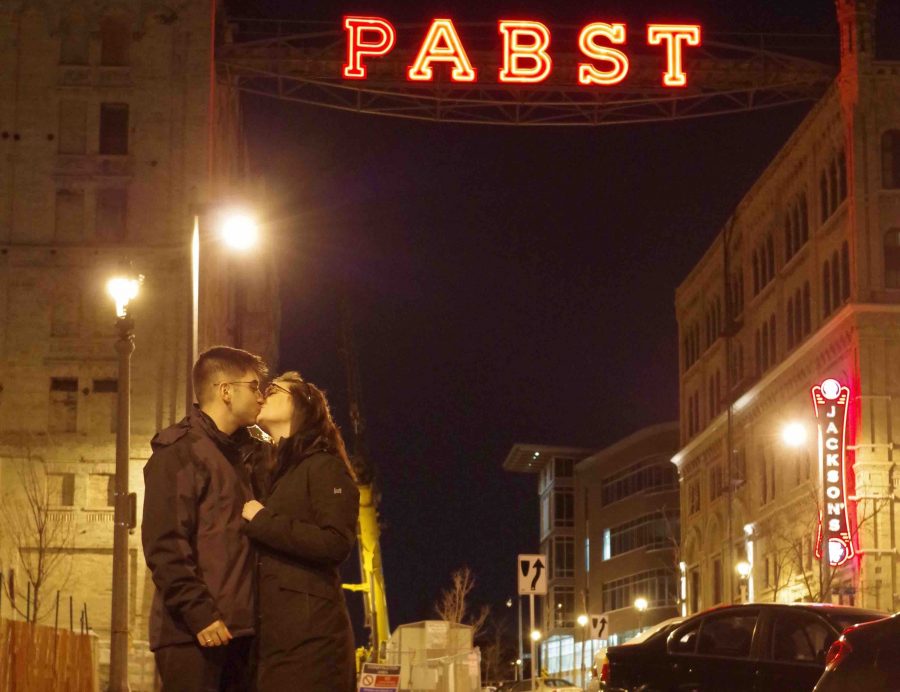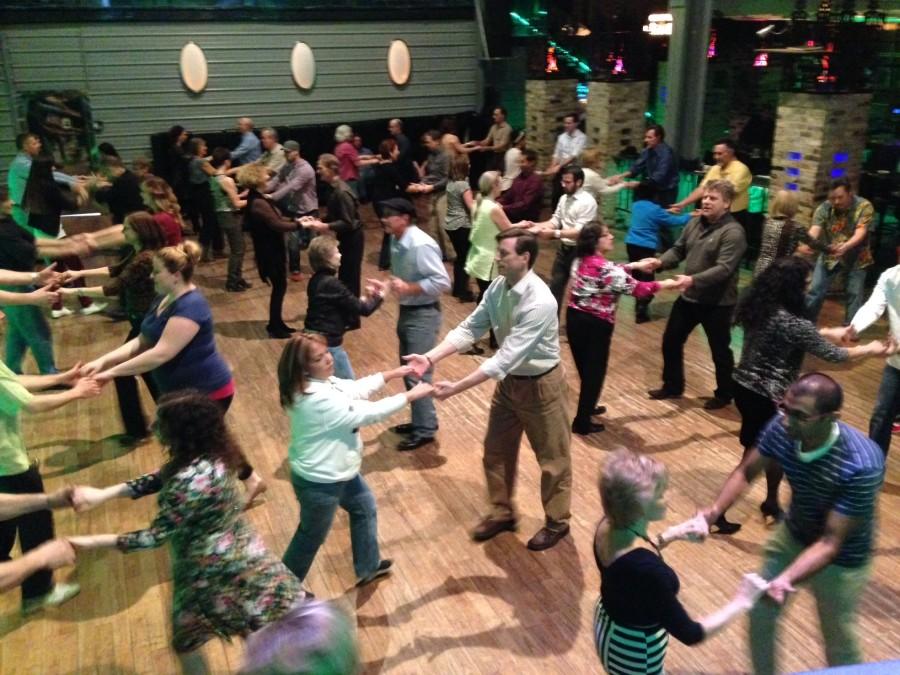
Movies like “Take the Lead,” “Dirty Dancing” and “Shall We Dance” always make my eyes glaze over in envy. I wish I could move like that.
I took tap and ballet lessons through fifth grade and was on my high school’s dance team for a year, but those aren’t the passionate, flamboyant dances you can bust out and impress everyone with at a friend’s wedding.
So when I had the chance to write this feature on swing dancing in Milwaukee, I should have been excited to learn the moves I’d always dreamed of. But with everything else I needed to accomplish last Tuesday, it seemed like interviewing regulars at the Milwaukee Ale House about swing dancing was the last thing I should be doing.
I expected to scribble down some notes as a quiet observer, hear what a few of the dancers had to say about their experience and sprint back to campus to finish my English paper. But by the time I left, my attitude had completely changed.
—
The term “swing dance” refers to the group of dances that developed alongside the swing style of music in the 1920s, ’30s and ’40s. Swing was defined by the original Swing Dance Council in 1985 as “an all-American couples’ rhythm dance consisting primarily of six- and eight-beat patterns that cover either a circular or slotted area on the dance floor.” The best known of these dances is the Lindy Hop, a popular partner dance that originated in Harlem, which is still danced today.
Swing dancing in Milwaukee is spread across a variety of groups, including Cream City Swing, the Milwaukee Rebels, the Brew City Hops and the Jumpin’ Jive Club. Each club offers beginner swing lessons at various downtown locations throughout the week.
Andrea Toussaint, director of Cream City Swing, said even though each club is its own distinct entity, they consider themselves part of a community. Every club has something happening at least one night a week, and they try not to schedule special classes or events on each other’s nights, she said.
Cream City Swing offers hour-long beginner’s lessons at 8 p.m. every Thursday at the Bay View Brew Haus, followed by open dance from 9 p.m. to 11:30 p.m. Cream City has a weekly rotating circuit of six couples who lead the beginner lessons, Toussaint said.
These six couples teach newcomers a six-count “East Coast Swing,” a form of swing dancing derived from the Lindy Hop. It is danced under fast swing music, including rock and roll and boogie-woogie.
Toussaint said East Coast Swing is easy to pick up in a short period of time. This way, beginners will hopefully have enough confidence in the basic steps to go out on the floor for open dance and have a good time.
Toussaint said Cream City attracts a wide variety of people each week, the crowds usually consisting of completely contrasting demographics, ranging in age from 21 to 70.
“The best thing about dancing is that it’s an activity where anybody who has a passion for it can do it,” she said. “Anybody can come and feel comfortable because their age group is represented.”
She said this wide variety is important because it allows dancers to personally introduce themselves to people they might not encounter on an everyday basis, allowing people to be more comfortable with the experience. Toussaint said dancing also helps people reconnect with their roots.
“(Swing dancing) is a time-honored tradition,” she said. “It’s the first and only American folk dance, so why not keep it alive?”
Keeping up the swing tradition was what inspired Maureen Majeski, founder and director of The Jumpin’ Jive Club, to start her own club about 15 years ago.
“(Dancing) brought me so much joy and made me feel so good that the idea of bringing it into the community just sounded like a good idea to me,” Majeski said.
Majeski said she traveled to swing workshops and took lessons for about two years before she began teaching lessons herself. More than four years ago she recruited her assistant, Stephanie Wise.
The pair now teach beginners’ classes at Rooter’s Night Club on Mondays at 8 p.m., the Milwaukee Ale House on Tuesdays at 8 p.m. and select Wednesdays at various locations.
Majeski said she feels blessed with the opportunity to teach and encourages everyone to give dancing a shot, if only as a stress-reliever.
“There’s something about creating fun in people’s lives that doesn’t seem easy to do,” she said. “(Dancing) can be a release for people who work and worry all day to have a dance class to come to.”
—
When I walked into the Ale House, I struggled to find Majeski and Wise, expecting the lesson to take place in some kind of semi-private area of the restaurant. The hostess pointed me in the direction I had just come from: the bar.
Upon finding Majeski, she introduced me to Jeff Lindsey, an Ale House Tuesday night swing regular for nine years now. Sitting off to the side of the “dance floor” with a beer in his hand, Lindsey didn’t quite strike me as “swing regular” material; in my mind, a regular here would be the stereotypical tall, dark, suave and mysterious man wearing a zoot suit and a fedora.
Lindsey, on the other hand, was a short, stocky, friendly middle-aged man sporting tennies and a t-shirt. After talking to him for just a few minutes, I could tell he was in love with swing. His eyes lit up as he told me how he comes to open dance almost every week, with few exceptions.
He said the allure for him was in the music variety, the dancing community and “even sitting and watching.”
“When it’s jumpin’, it’s just jumpin’,” he said.
I couldn’t convince my friends to come swing dancing with me, but Lindsey assured me that wouldn’t be a problem.
“You rotate partners about every two minutes,” he said. “You dance with everyone in the lesson, so it’s very social.”
But I must have looked hesitant or disbelieving, especially since I’d left my jacket and backpack on our entire conversation, because a moment later, Lindsey asked, “So, you’re gonna stay for the lesson, right?” A smile curled about his face, as if he knew what my answer was going to have to be.
A few minutes later, Majeski and Wise climbed on stage and started teaching the first few steps. Before I knew it, my hands were intertwined with a 78-year-old-looking man who smelled of cigar boxes.
Majeski and Wise taught through demonstration, Majeski as the “leader” and Wise as the “follower.” First, we went slowly through the basic footwork. After everyone seemed to have it down, we took the steps faster until Majeski added music into the mix.
Two minutes later, just like Lindsey promised, I moved on to dance partner number two: a middle-aged swing regular with a Hawaiian button-up and a ponytail. Together, we practiced adding a spin into the footwork.
My third partner was a timid, well-dressed man in his 20s who seemed fearful he might break my hand if he held it too tightly. With him, I learned “closed position,” where partners stand arm in arm beside each other, rather than hand in hand facing one another.
By the end of the lesson, I had met about 20 of the most diverse, outgoing, rhythmic men I will probably ever again meet in a 50-minute time period. They helped me forget all the stress I’d felt back on campus, and I left feeling renewed and upbeat, my time spent on a much more exciting endeavor than Facebooking in my dorm.
I know I’ll be back. And next time I pop in “Dirty Dancing,” I’ll feel just a little less envious.
The Jumpin’ Jive Club: Mondays at Rooter’s Nightclub, 901 Northview Rd., Waukesha. Lindy Hop lesson 7 p.m., Swing Dance lesson 8 p.m., $6 each. Tuesdays at the Milwaukee Ale House, 233 N. Water St. Swing Dance lesson 8 p.m., $6. Visit jumpinjiveclub.com or call 262-547-9464 for more info.
Cream City Swing: Thursdays at The Bay View Brew Haus, 2535 S. Kinnickinnic Ave. Swing Dance lesson 8 p.m., $5. Visit ccswing.com or call 414-481-8060 for more info.




